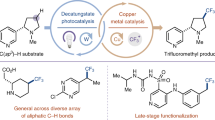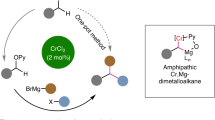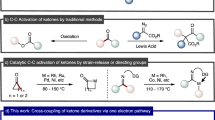Abstract
Two-component C–H bond additions to a large variety of coupling partners have been developed with applications towards materials, natural product and drug synthesis. Sequential three-component C–H bond addition across two different coupling partners potentially enables the convergent synthesis of complex molecular scaffolds from simple precursors. Here, we report three-component Co(iii)-catalysed C–H bond additions to dienes and aldehydes that proceed with high regio- and stereoselectivity, resulting in two new carbon–carbon σ-bonds and four to six new stereocentres. The reaction relies on the synergistic reactivity of the diene and aldehyde, with neither undergoing C–H bond addition alone. A detailed mechanism is supported by X-ray structural characterization of a Co(iii)-allyl intermediate, observed transfer of stereochemical information, and kinetic isotope studies. The applicability of the method to biologically relevant molecules is exemplified by the rapid synthesis of the western fragment of the complex ionophore antibiotic lasalocid A.
This is a preview of subscription content, access via your institution
Access options
Access Nature and 54 other Nature Portfolio journals
Get Nature+, our best-value online-access subscription
$29.99 / 30 days
cancel any time
Subscribe to this journal
Receive 12 digital issues and online access to articles
$119.00 per year
only $9.92 per issue
Buy this article
- Purchase on Springer Link
- Instant access to full article PDF
Prices may be subject to local taxes which are calculated during checkout






Similar content being viewed by others
References
Dömling, A. & Ugi, I. Multicomponent reactions with isocyanides. Angew. Chem. Int. Ed. 39, 3168–3210 (2000).
Ramón, D. J. & Yus, M. Asymmetric multicomponent reactions (AMCRs): the new frontier. Angew. Chem. Int. Ed. 44, 1602–1634 (2005).
D’Souza, D. M. & Müller, T. J. J. Multi-component syntheses of heterocycles by transition-metal catalysis. Chem. Soc. Rev. 36, 1095–1108 (2007).
Ye, J. & Lautens, M. Palladium-catalysed norbornene-mediated C–H functionalization of arenes. Nat. Chem. 7, 863–870 (2015).
Davies, H. M. L. & Manning, J. R. Catalytic C–H bond functionalization by metal carbenoid and nitrenoid insertion. Nature 451, 417–424 (2008).
Yamaguchi, J., Yamaguchi, A. D. & Itami, K. C–H bond functionalization: emerging synthetic tools for natural products and pharmaceuticals. Angew. Chem. Int. Ed. 51, 8960–9009 (2012).
Wencel-Delord, J. & Glorius, F. C–H bond activation enables the rapid construction and late-stage diversification of functional molecules. Nat. Chem. 5, 369–375 (2013).
Yoshino, T. & Matsunaga, S. (Pentamethylcyclopentadienyl)cobalt(iii)-catalyzed C–H bond functionalization: from discovery to unique reactivity and selectivity. Adv. Synth. Catal. 359, 1245–1262 (2017).
Crabtree, R. H. & Lei, A. Introduction: CH activation. Chem. Rev. 117, 8481–9520 (2017).
Blakemore, D. C. et al. Organic synthesis provides opportunities to transform drug discovery. Nat. Chem. 10, 383–394 (2018).
Boerth, J. A. & Ellman, J. A. A convergent synthesis of functionalized alkenyl halides through cobalt(iii)-catalyzed three-component C–H bond addition. Angew. Chem. Int. Ed. 56, 9976–9980 (2017).
Boerth, J. A., Hummel, J. R. & Ellman, J. A. Highly stereoselective cobalt(iii)-catalyzed three-component C−H bond addition cascade. Angew. Chem. Int. Ed. 55, 12650–12654 (2016).
Allen, A. E. & MacMillan, D. W. C. Synergistic catalysis: a powerful synthetic strategy for new reaction development. Chem. Sci. 3, 633–658 (2012).
Montgomery, J. Nickel-catalyzed reductive cyclizations and couplings. Angew. Chem. Int. Ed. 43, 3890–3908 (2004).
Yang, Y., Perry, I. B., Lu, G., Liu, P. & Buchwald, S. L. Copper-catalyzed asymmetric addition of olefin-derived nucleophiles to ketones. Science 353, 144–150 (2016).
Zbieg, J. R., Yamaguchi, E., McInturff, E. L. & Krische, M. J. Enantioselective C–H crotylation of primary alcohols via hydrohydroxyalkylation of butadiene. Science 336, 324–327 (2012).
Cho, H. Y. & Morken, J. P. Diastereoselective construction of functionalized homoallylic alcohols by Ni-catalyzed diboron-promoted coupling of dienes and aldehydes. J. Am. Chem. Soc. 130, 16140–16141 (2008).
Hummel, J. R. & Ellman, J. A. Cobalt(iii)-catalyzed synthesis of indazoles and furans by C–H bond functionalization/addition/cyclization cascades. J. Am. Chem. Soc. 137, 490–498 (2015).
Yoshino, T., Ikemoto, H., Matsunaga, S. & Kanai, M. A cationic high-valent Cp*CoIII complex for the catalytic generation of nucleophilic organometallic species: directed C–H bond activation. Angew. Chem. Int. Ed. 52, 2207–2211 (2013).
Vitaku, E., Smith, D. T. & Njardson, J. T. Analysis of the structural diversity, substitution patterns, and frequency of nitrogen heterocycles among U.S. FDA approved pharmaceuticals. J. Med. Chem. 57, 10257–10274 (2014).
Schneider, N., Lowe, D. M., Sayle, R. A., Tarselli, M. A. & Landrum, G. A. Big data from pharmaceutical patents: a computational analysis of medicinal chemists’ bread and butter. J. Med. Chem. 59, 4385–4402 (2016).
Nahm, S. & Weinreb, S. M. N-methoxy-N-methylamides as effective acylating agents. Tetrahedr. Lett. 22, 3815–3818 (1981).
Li, H. et al. Pyridinyl directed alkenylation with olefins via Rh(iii)-catalyzed C–C bond cleavage of secondary arylmethanols. J. Am. Chem. Soc. 133, 15244–15247 (2011).
Ozkal, E., Cacherat, B. & Morandi, B. Cobalt(iii)-catalyzed functionalization of unstrained carbon–carbon bonds through β-carbon cleavage of alcohols. ACS Catal. 5, 6458–6462 (2015).
Sen, M., Rajesh, N., Emayavaramban, B., Premkumar, J. R. & Sundararaju, B. Isolation of Cp*CoIII–alkenyl intermediate in efficient cobalt-catalyzed C−H alkenylation with alkynes. Chem. Eur. J. 24, 342–346 (2018).
Simmons, E. M. & Hartwig, J. F. On the interpretation of deuterium kinetic isotope effects in C–H bond functionalizations by transition-metal complexes. Angew. Chem. Int. Ed. 51, 3066–3072 (2012).
Korkis, S. E., Burns, D. J. & Lam, H. W. Rhodium-catalyzed oxidative C−H allylation of benzamides with 1,3-dienes by allyl-to-allyl 1,4-Rh(iii) migration. J. Am. Chem. Soc. 138, 12252–12257 (2016).
Hirano, M., Shibasaki, T., Komiya, S. & Bennett, M. A. Synthesis of and stereospecific hydride migration in cationic (tricyclic arene)(cyclooctadiene)ruthenium(ii) complexes. Organometallics 21, 5738–5745 (2002).
Nakata, T. et al. A total synthesis of lasalocid A. J. Am. Chem. Soc. 100, 2933–2935 (1978).
Ireland, R. E. et al. The total synthesis of ionophore antibiotics. A convergent synthesis of lasalocid A (X537A). J. Am. Chem. Soc. 105, 1988–2006 (1983).
Sajiki, H., Hattori, K. & Hirota, K. The formation of a novel Pd/C-ethylenediamine complex catalyst: chemoselective hydrogenation without deprotection of the O-benzyl and N-Cbz groups. J. Org. Chem. 63, 7990–7992 (1998).
White, E. H. The chemistry of the N-alkyl-N-nitrosoamides. I. Methods of preparation. J. Am. Chem. Soc. 77, 6008–6010 (1955).
Acknowledgements
This work was supported by the NIH (R35GM122473).
Author information
Authors and Affiliations
Contributions
J.A.B. co-conceived the concept and developed the reaction conditions. J.A.B. also completed the scope with respect to C–H bond substrates, including the lasalocid A derivative, conducted the mechanistic experiments and co-prepared the manuscript. S.M. helped with the development of the reaction conditions and completed the scope with respect to both aldehyde and diene coupling partners. S.M. also helped with the preparation of the manuscript. S.K.W. helped with the completion of the scope with respect to C–H bond substrates. B.Q.M. solved the X-ray crystal structures of compounds 4b, 4ar′ and 8a. J.A.E. co-conceived the concept and co-prepared the manuscript with feedback from J.A.B. and S.M.
Corresponding author
Ethics declarations
Competing interests
The authors declare no competing interests.
Additional information
Publisher’s note: Springer Nature remains neutral with regard to jurisdictional claims in published maps and institutional affiliations.
Supplementary information
Supplementary Information
Supplementary Methods, Supplementary Figures 1–5, Supplementary Tables 1 & 2, Supplementary References
Supplementary Information
Crystallographic data for compound 4b, CCDC reference 1812525
Supplementary Information
Crystallographic data for compound 4ar’, CCDC reference 1826301
Supplementary Information
Crystallographic data for compound 8a, CCDC reference 1812526
Rights and permissions
About this article
Cite this article
Boerth, J.A., Maity, S., Williams, S.K. et al. Selective and synergistic cobalt(iii)-catalysed three-component C–H bond addition to dienes and aldehydes. Nat Catal 1, 673–679 (2018). https://doi.org/10.1038/s41929-018-0123-4
Received:
Accepted:
Published:
Issue Date:
DOI: https://doi.org/10.1038/s41929-018-0123-4
This article is cited by
-
Stereoselective cyclohexadienylamine synthesis through rhodium-catalysed [2+2+2] cyclotrimerization
Nature Synthesis (2022)
-
Cobalt-catalyzed divergent functionalization of N-sulfonyl amines via β-carbon elimination
Science China Chemistry (2022)



